Nestle's Marketing Strategies and Impact
VerifiedAdded on 2020/05/16
|13
|3839
|77
AI Summary
This assignment delves into Nestle's diverse marketing strategies, focusing on its approach to building customer relationships, managing brand reputation, and navigating the competitive food and beverage industry. It requires an in-depth analysis of Nestle's marketing mix, stakeholder engagement, and the impact of its strategies on various aspects of the business.
Contribute Materials
Your contribution can guide someone’s learning journey. Share your
documents today.
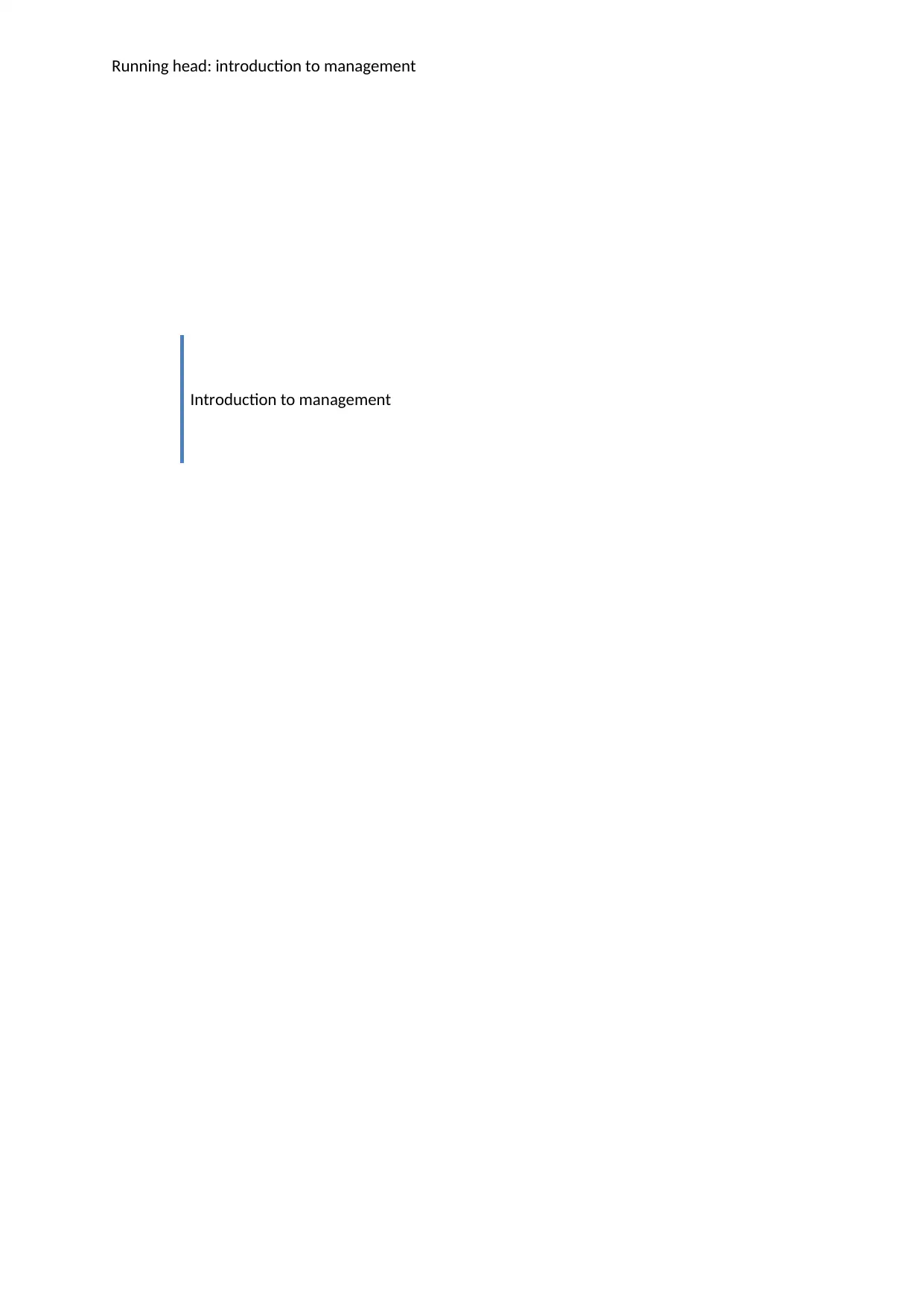
Running head: introduction to management
Introduction to management
Introduction to management
Secure Best Marks with AI Grader
Need help grading? Try our AI Grader for instant feedback on your assignments.
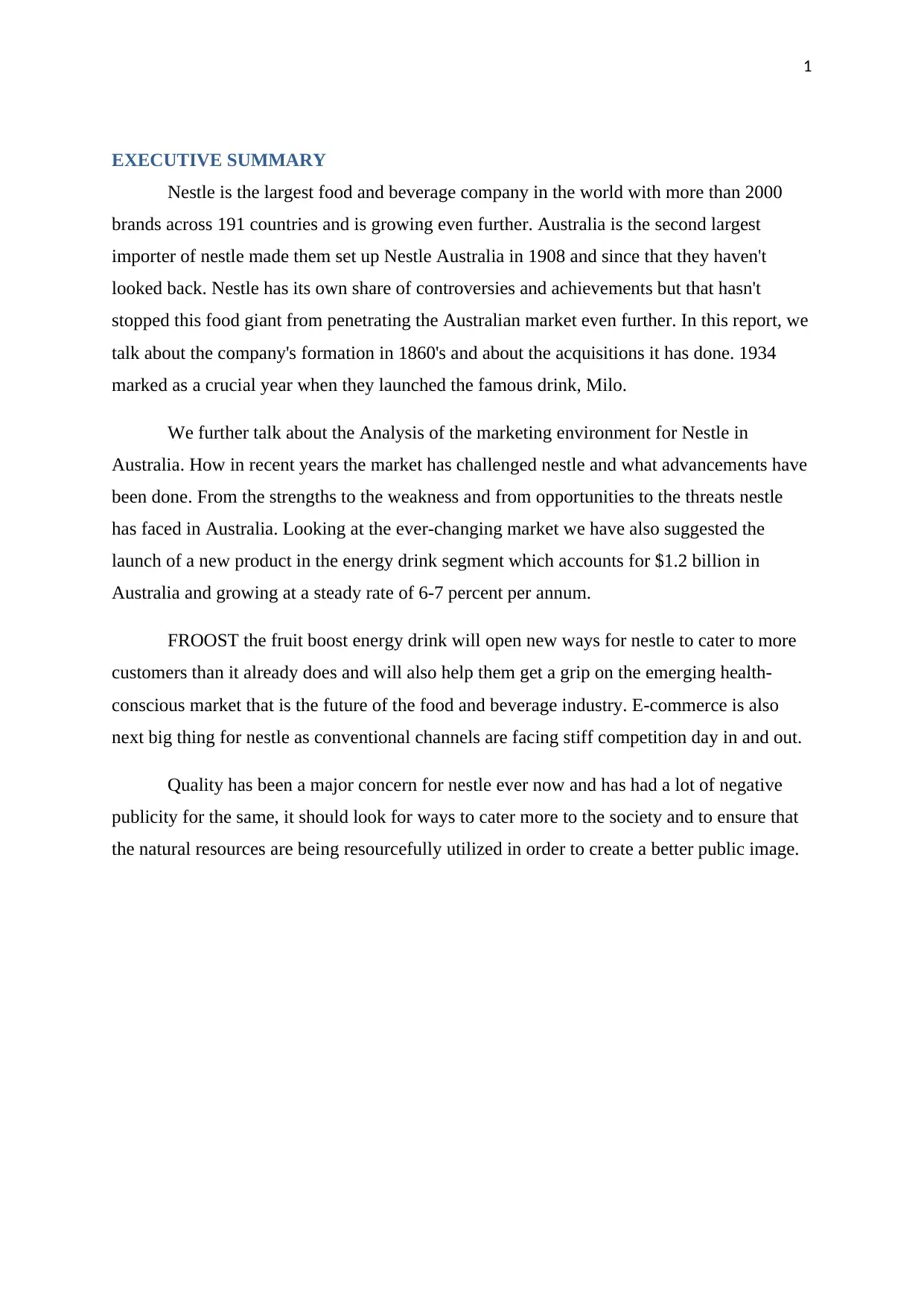
1
EXECUTIVE SUMMARY
Nestle is the largest food and beverage company in the world with more than 2000
brands across 191 countries and is growing even further. Australia is the second largest
importer of nestle made them set up Nestle Australia in 1908 and since that they haven't
looked back. Nestle has its own share of controversies and achievements but that hasn't
stopped this food giant from penetrating the Australian market even further. In this report, we
talk about the company's formation in 1860's and about the acquisitions it has done. 1934
marked as a crucial year when they launched the famous drink, Milo.
We further talk about the Analysis of the marketing environment for Nestle in
Australia. How in recent years the market has challenged nestle and what advancements have
been done. From the strengths to the weakness and from opportunities to the threats nestle
has faced in Australia. Looking at the ever-changing market we have also suggested the
launch of a new product in the energy drink segment which accounts for $1.2 billion in
Australia and growing at a steady rate of 6-7 percent per annum.
FROOST the fruit boost energy drink will open new ways for nestle to cater to more
customers than it already does and will also help them get a grip on the emerging health-
conscious market that is the future of the food and beverage industry. E-commerce is also
next big thing for nestle as conventional channels are facing stiff competition day in and out.
Quality has been a major concern for nestle ever now and has had a lot of negative
publicity for the same, it should look for ways to cater more to the society and to ensure that
the natural resources are being resourcefully utilized in order to create a better public image.
EXECUTIVE SUMMARY
Nestle is the largest food and beverage company in the world with more than 2000
brands across 191 countries and is growing even further. Australia is the second largest
importer of nestle made them set up Nestle Australia in 1908 and since that they haven't
looked back. Nestle has its own share of controversies and achievements but that hasn't
stopped this food giant from penetrating the Australian market even further. In this report, we
talk about the company's formation in 1860's and about the acquisitions it has done. 1934
marked as a crucial year when they launched the famous drink, Milo.
We further talk about the Analysis of the marketing environment for Nestle in
Australia. How in recent years the market has challenged nestle and what advancements have
been done. From the strengths to the weakness and from opportunities to the threats nestle
has faced in Australia. Looking at the ever-changing market we have also suggested the
launch of a new product in the energy drink segment which accounts for $1.2 billion in
Australia and growing at a steady rate of 6-7 percent per annum.
FROOST the fruit boost energy drink will open new ways for nestle to cater to more
customers than it already does and will also help them get a grip on the emerging health-
conscious market that is the future of the food and beverage industry. E-commerce is also
next big thing for nestle as conventional channels are facing stiff competition day in and out.
Quality has been a major concern for nestle ever now and has had a lot of negative
publicity for the same, it should look for ways to cater more to the society and to ensure that
the natural resources are being resourcefully utilized in order to create a better public image.
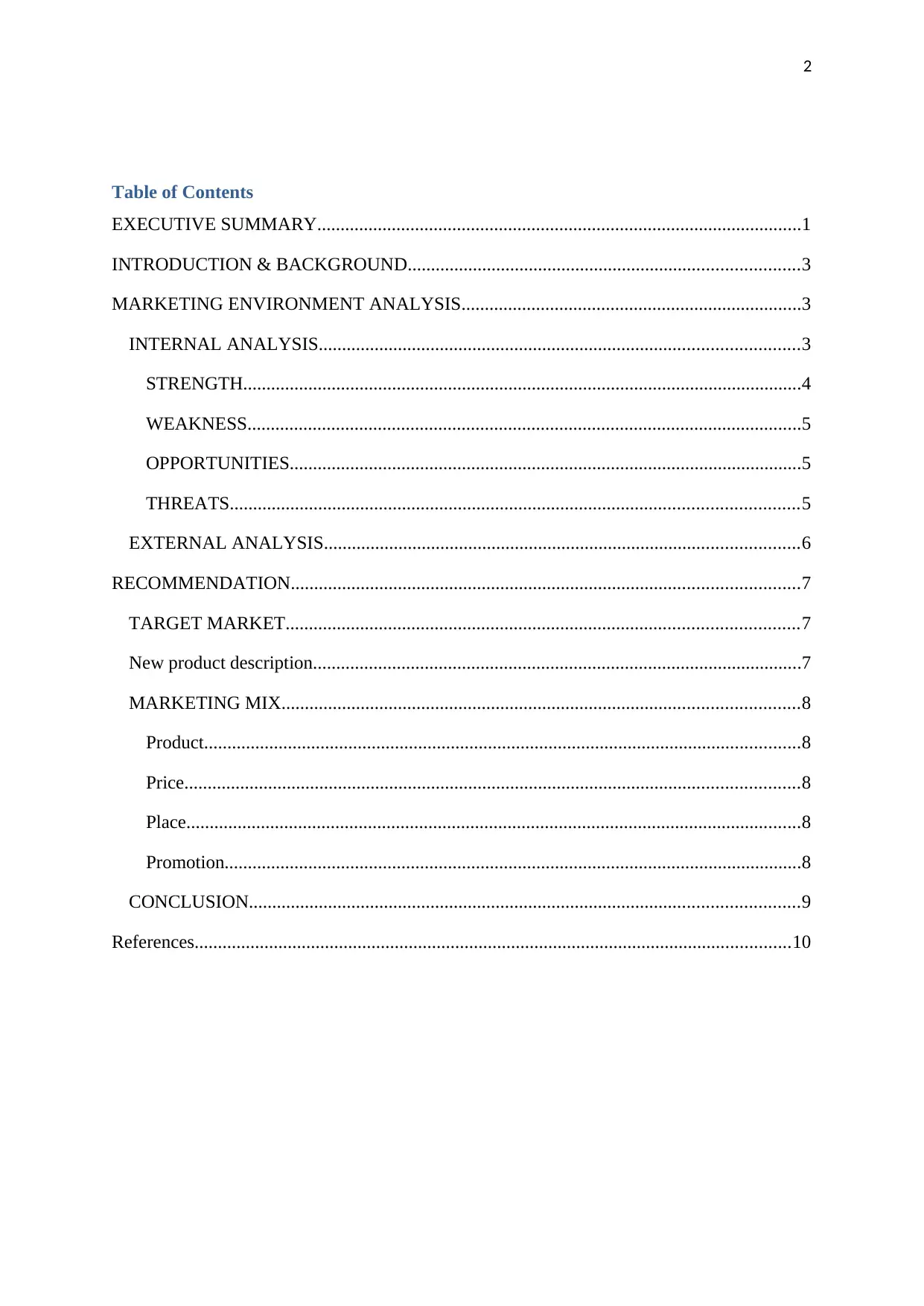
2
Table of Contents
EXECUTIVE SUMMARY........................................................................................................1
INTRODUCTION & BACKGROUND....................................................................................3
MARKETING ENVIRONMENT ANALYSIS.........................................................................3
INTERNAL ANALYSIS.......................................................................................................3
STRENGTH........................................................................................................................4
WEAKNESS.......................................................................................................................5
OPPORTUNITIES..............................................................................................................5
THREATS..........................................................................................................................5
EXTERNAL ANALYSIS......................................................................................................6
RECOMMENDATION.............................................................................................................7
TARGET MARKET..............................................................................................................7
New product description.........................................................................................................7
MARKETING MIX...............................................................................................................8
Product................................................................................................................................8
Price....................................................................................................................................8
Place....................................................................................................................................8
Promotion............................................................................................................................8
CONCLUSION......................................................................................................................9
References................................................................................................................................10
Table of Contents
EXECUTIVE SUMMARY........................................................................................................1
INTRODUCTION & BACKGROUND....................................................................................3
MARKETING ENVIRONMENT ANALYSIS.........................................................................3
INTERNAL ANALYSIS.......................................................................................................3
STRENGTH........................................................................................................................4
WEAKNESS.......................................................................................................................5
OPPORTUNITIES..............................................................................................................5
THREATS..........................................................................................................................5
EXTERNAL ANALYSIS......................................................................................................6
RECOMMENDATION.............................................................................................................7
TARGET MARKET..............................................................................................................7
New product description.........................................................................................................7
MARKETING MIX...............................................................................................................8
Product................................................................................................................................8
Price....................................................................................................................................8
Place....................................................................................................................................8
Promotion............................................................................................................................8
CONCLUSION......................................................................................................................9
References................................................................................................................................10
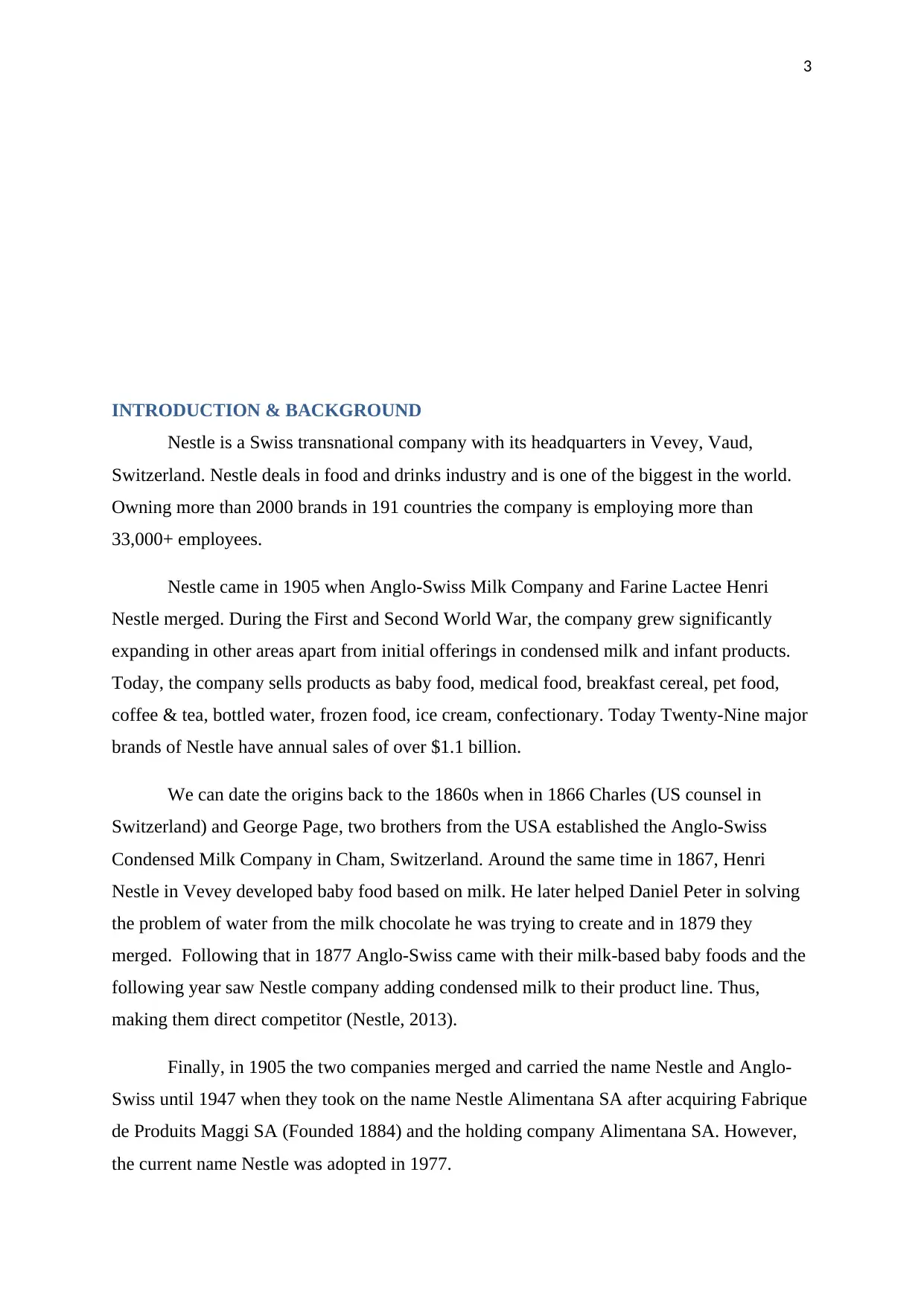
3
INTRODUCTION & BACKGROUND
Nestle is a Swiss transnational company with its headquarters in Vevey, Vaud,
Switzerland. Nestle deals in food and drinks industry and is one of the biggest in the world.
Owning more than 2000 brands in 191 countries the company is employing more than
33,000+ employees.
Nestle came in 1905 when Anglo-Swiss Milk Company and Farine Lactee Henri
Nestle merged. During the First and Second World War, the company grew significantly
expanding in other areas apart from initial offerings in condensed milk and infant products.
Today, the company sells products as baby food, medical food, breakfast cereal, pet food,
coffee & tea, bottled water, frozen food, ice cream, confectionary. Today Twenty-Nine major
brands of Nestle have annual sales of over $1.1 billion.
We can date the origins back to the 1860s when in 1866 Charles (US counsel in
Switzerland) and George Page, two brothers from the USA established the Anglo-Swiss
Condensed Milk Company in Cham, Switzerland. Around the same time in 1867, Henri
Nestle in Vevey developed baby food based on milk. He later helped Daniel Peter in solving
the problem of water from the milk chocolate he was trying to create and in 1879 they
merged. Following that in 1877 Anglo-Swiss came with their milk-based baby foods and the
following year saw Nestle company adding condensed milk to their product line. Thus,
making them direct competitor (Nestle, 2013).
Finally, in 1905 the two companies merged and carried the name Nestle and Anglo-
Swiss until 1947 when they took on the name Nestle Alimentana SA after acquiring Fabrique
de Produits Maggi SA (Founded 1884) and the holding company Alimentana SA. However,
the current name Nestle was adopted in 1977.
INTRODUCTION & BACKGROUND
Nestle is a Swiss transnational company with its headquarters in Vevey, Vaud,
Switzerland. Nestle deals in food and drinks industry and is one of the biggest in the world.
Owning more than 2000 brands in 191 countries the company is employing more than
33,000+ employees.
Nestle came in 1905 when Anglo-Swiss Milk Company and Farine Lactee Henri
Nestle merged. During the First and Second World War, the company grew significantly
expanding in other areas apart from initial offerings in condensed milk and infant products.
Today, the company sells products as baby food, medical food, breakfast cereal, pet food,
coffee & tea, bottled water, frozen food, ice cream, confectionary. Today Twenty-Nine major
brands of Nestle have annual sales of over $1.1 billion.
We can date the origins back to the 1860s when in 1866 Charles (US counsel in
Switzerland) and George Page, two brothers from the USA established the Anglo-Swiss
Condensed Milk Company in Cham, Switzerland. Around the same time in 1867, Henri
Nestle in Vevey developed baby food based on milk. He later helped Daniel Peter in solving
the problem of water from the milk chocolate he was trying to create and in 1879 they
merged. Following that in 1877 Anglo-Swiss came with their milk-based baby foods and the
following year saw Nestle company adding condensed milk to their product line. Thus,
making them direct competitor (Nestle, 2013).
Finally, in 1905 the two companies merged and carried the name Nestle and Anglo-
Swiss until 1947 when they took on the name Nestle Alimentana SA after acquiring Fabrique
de Produits Maggi SA (Founded 1884) and the holding company Alimentana SA. However,
the current name Nestle was adopted in 1977.
Secure Best Marks with AI Grader
Need help grading? Try our AI Grader for instant feedback on your assignments.
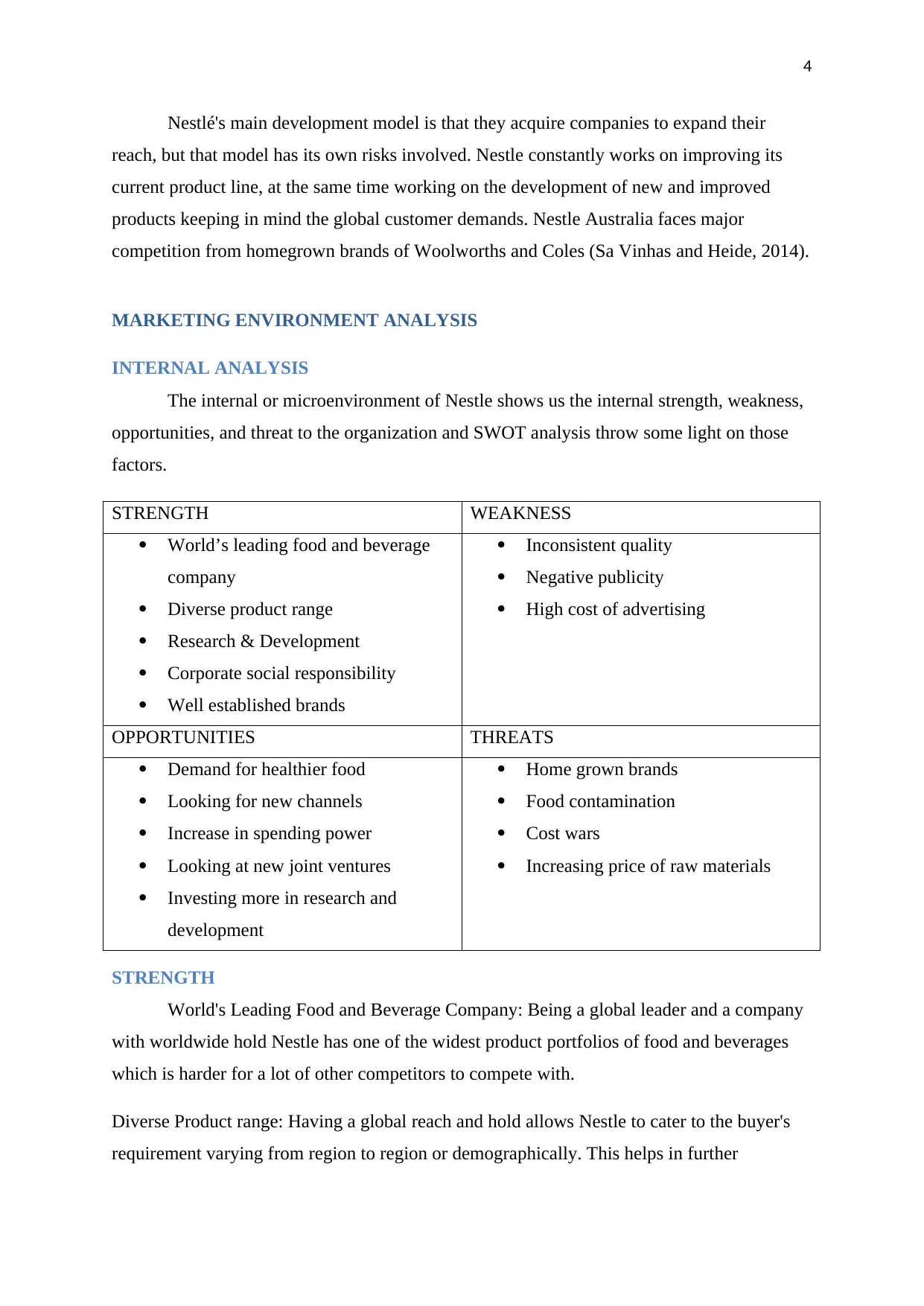
4
Nestlé's main development model is that they acquire companies to expand their
reach, but that model has its own risks involved. Nestle constantly works on improving its
current product line, at the same time working on the development of new and improved
products keeping in mind the global customer demands. Nestle Australia faces major
competition from homegrown brands of Woolworths and Coles (Sa Vinhas and Heide, 2014).
MARKETING ENVIRONMENT ANALYSIS
INTERNAL ANALYSIS
The internal or microenvironment of Nestle shows us the internal strength, weakness,
opportunities, and threat to the organization and SWOT analysis throw some light on those
factors.
STRENGTH WEAKNESS
World’s leading food and beverage
company
Diverse product range
Research & Development
Corporate social responsibility
Well established brands
Inconsistent quality
Negative publicity
High cost of advertising
OPPORTUNITIES THREATS
Demand for healthier food
Looking for new channels
Increase in spending power
Looking at new joint ventures
Investing more in research and
development
Home grown brands
Food contamination
Cost wars
Increasing price of raw materials
STRENGTH
World's Leading Food and Beverage Company: Being a global leader and a company
with worldwide hold Nestle has one of the widest product portfolios of food and beverages
which is harder for a lot of other competitors to compete with.
Diverse Product range: Having a global reach and hold allows Nestle to cater to the buyer's
requirement varying from region to region or demographically. This helps in further
Nestlé's main development model is that they acquire companies to expand their
reach, but that model has its own risks involved. Nestle constantly works on improving its
current product line, at the same time working on the development of new and improved
products keeping in mind the global customer demands. Nestle Australia faces major
competition from homegrown brands of Woolworths and Coles (Sa Vinhas and Heide, 2014).
MARKETING ENVIRONMENT ANALYSIS
INTERNAL ANALYSIS
The internal or microenvironment of Nestle shows us the internal strength, weakness,
opportunities, and threat to the organization and SWOT analysis throw some light on those
factors.
STRENGTH WEAKNESS
World’s leading food and beverage
company
Diverse product range
Research & Development
Corporate social responsibility
Well established brands
Inconsistent quality
Negative publicity
High cost of advertising
OPPORTUNITIES THREATS
Demand for healthier food
Looking for new channels
Increase in spending power
Looking at new joint ventures
Investing more in research and
development
Home grown brands
Food contamination
Cost wars
Increasing price of raw materials
STRENGTH
World's Leading Food and Beverage Company: Being a global leader and a company
with worldwide hold Nestle has one of the widest product portfolios of food and beverages
which is harder for a lot of other competitors to compete with.
Diverse Product range: Having a global reach and hold allows Nestle to cater to the buyer's
requirement varying from region to region or demographically. This helps in further
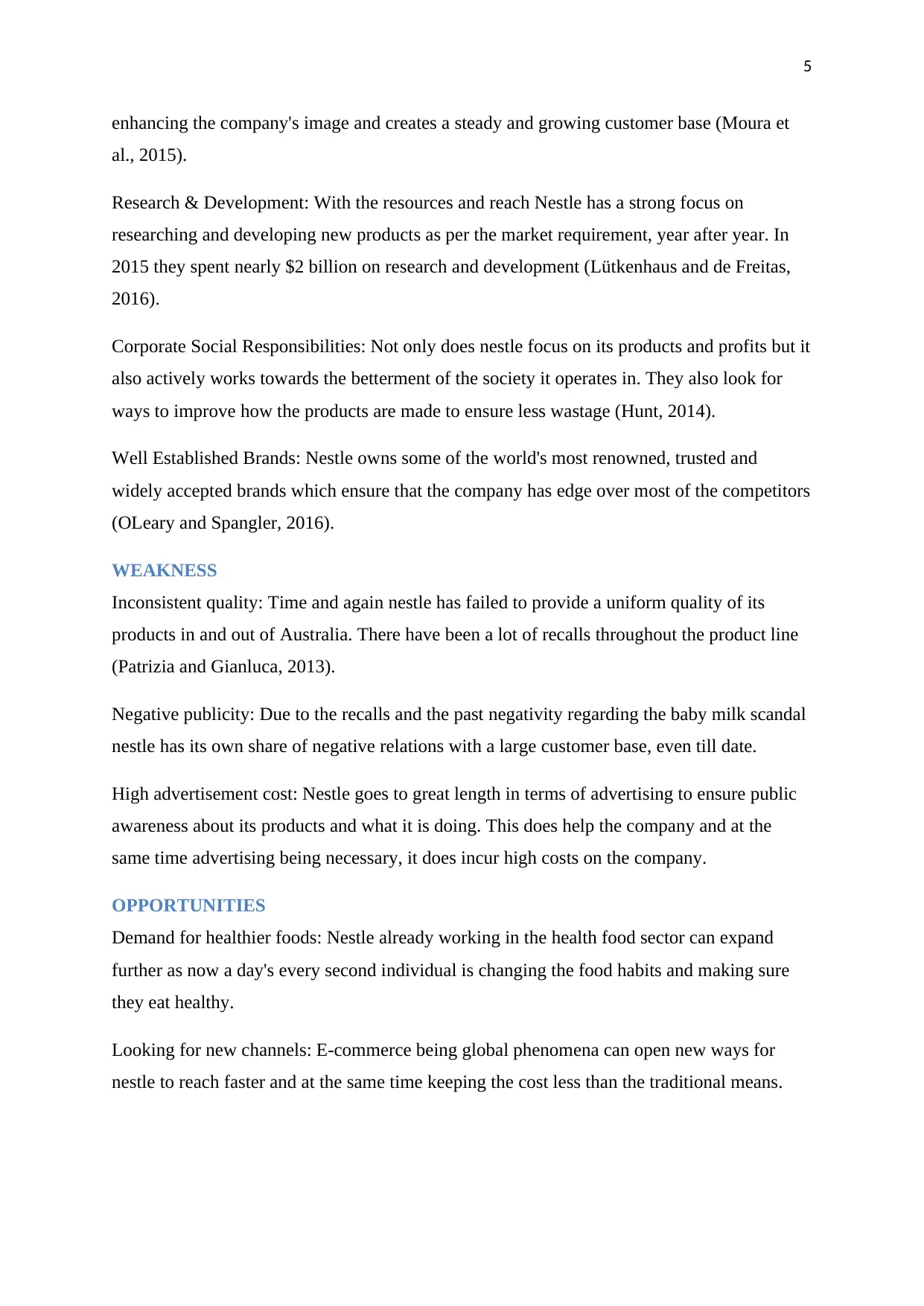
5
enhancing the company's image and creates a steady and growing customer base (Moura et
al., 2015).
Research & Development: With the resources and reach Nestle has a strong focus on
researching and developing new products as per the market requirement, year after year. In
2015 they spent nearly $2 billion on research and development (Lütkenhaus and de Freitas,
2016).
Corporate Social Responsibilities: Not only does nestle focus on its products and profits but it
also actively works towards the betterment of the society it operates in. They also look for
ways to improve how the products are made to ensure less wastage (Hunt, 2014).
Well Established Brands: Nestle owns some of the world's most renowned, trusted and
widely accepted brands which ensure that the company has edge over most of the competitors
(OLeary and Spangler, 2016).
WEAKNESS
Inconsistent quality: Time and again nestle has failed to provide a uniform quality of its
products in and out of Australia. There have been a lot of recalls throughout the product line
(Patrizia and Gianluca, 2013).
Negative publicity: Due to the recalls and the past negativity regarding the baby milk scandal
nestle has its own share of negative relations with a large customer base, even till date.
High advertisement cost: Nestle goes to great length in terms of advertising to ensure public
awareness about its products and what it is doing. This does help the company and at the
same time advertising being necessary, it does incur high costs on the company.
OPPORTUNITIES
Demand for healthier foods: Nestle already working in the health food sector can expand
further as now a day's every second individual is changing the food habits and making sure
they eat healthy.
Looking for new channels: E-commerce being global phenomena can open new ways for
nestle to reach faster and at the same time keeping the cost less than the traditional means.
enhancing the company's image and creates a steady and growing customer base (Moura et
al., 2015).
Research & Development: With the resources and reach Nestle has a strong focus on
researching and developing new products as per the market requirement, year after year. In
2015 they spent nearly $2 billion on research and development (Lütkenhaus and de Freitas,
2016).
Corporate Social Responsibilities: Not only does nestle focus on its products and profits but it
also actively works towards the betterment of the society it operates in. They also look for
ways to improve how the products are made to ensure less wastage (Hunt, 2014).
Well Established Brands: Nestle owns some of the world's most renowned, trusted and
widely accepted brands which ensure that the company has edge over most of the competitors
(OLeary and Spangler, 2016).
WEAKNESS
Inconsistent quality: Time and again nestle has failed to provide a uniform quality of its
products in and out of Australia. There have been a lot of recalls throughout the product line
(Patrizia and Gianluca, 2013).
Negative publicity: Due to the recalls and the past negativity regarding the baby milk scandal
nestle has its own share of negative relations with a large customer base, even till date.
High advertisement cost: Nestle goes to great length in terms of advertising to ensure public
awareness about its products and what it is doing. This does help the company and at the
same time advertising being necessary, it does incur high costs on the company.
OPPORTUNITIES
Demand for healthier foods: Nestle already working in the health food sector can expand
further as now a day's every second individual is changing the food habits and making sure
they eat healthy.
Looking for new channels: E-commerce being global phenomena can open new ways for
nestle to reach faster and at the same time keeping the cost less than the traditional means.
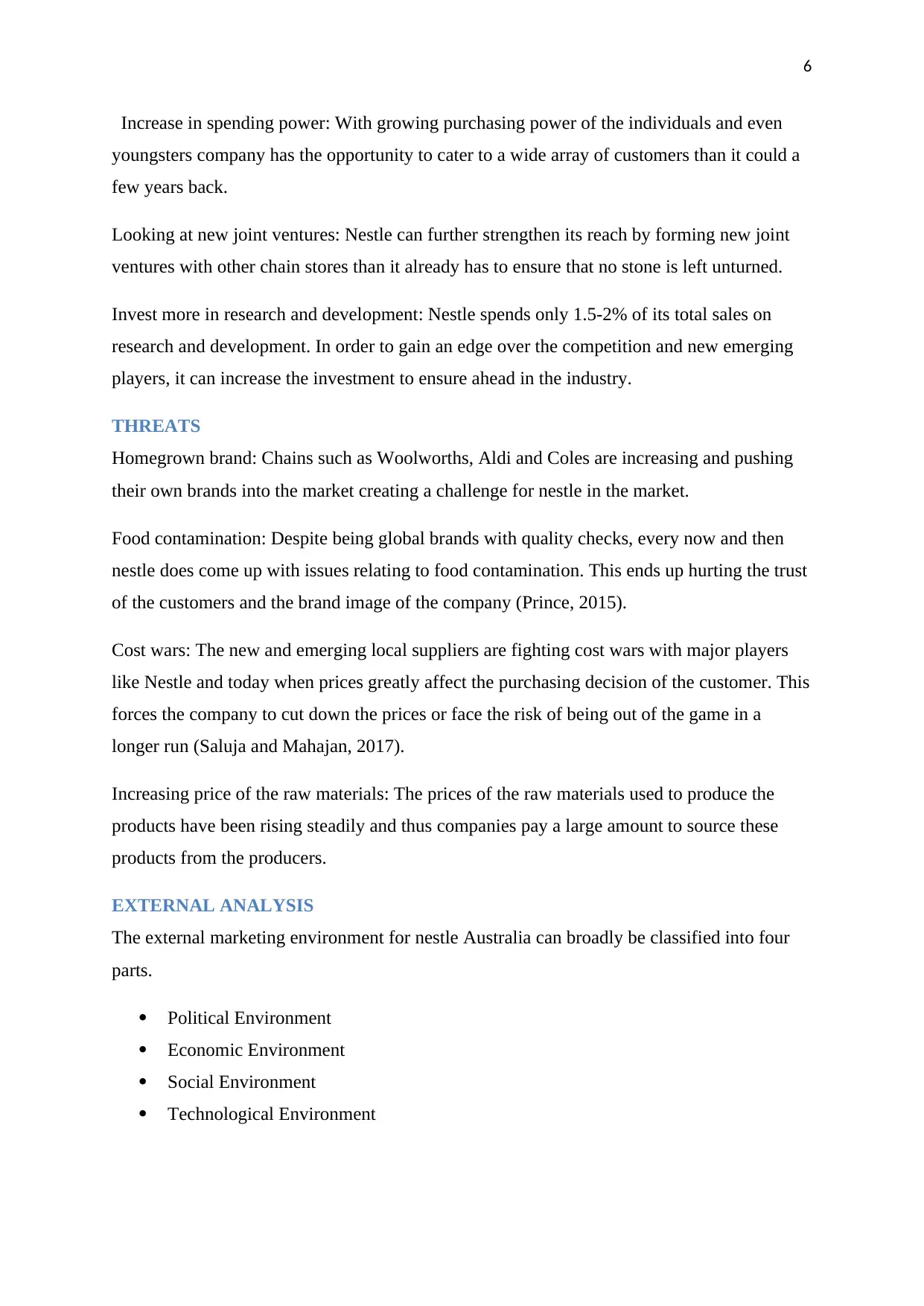
6
Increase in spending power: With growing purchasing power of the individuals and even
youngsters company has the opportunity to cater to a wide array of customers than it could a
few years back.
Looking at new joint ventures: Nestle can further strengthen its reach by forming new joint
ventures with other chain stores than it already has to ensure that no stone is left unturned.
Invest more in research and development: Nestle spends only 1.5-2% of its total sales on
research and development. In order to gain an edge over the competition and new emerging
players, it can increase the investment to ensure ahead in the industry.
THREATS
Homegrown brand: Chains such as Woolworths, Aldi and Coles are increasing and pushing
their own brands into the market creating a challenge for nestle in the market.
Food contamination: Despite being global brands with quality checks, every now and then
nestle does come up with issues relating to food contamination. This ends up hurting the trust
of the customers and the brand image of the company (Prince, 2015).
Cost wars: The new and emerging local suppliers are fighting cost wars with major players
like Nestle and today when prices greatly affect the purchasing decision of the customer. This
forces the company to cut down the prices or face the risk of being out of the game in a
longer run (Saluja and Mahajan, 2017).
Increasing price of the raw materials: The prices of the raw materials used to produce the
products have been rising steadily and thus companies pay a large amount to source these
products from the producers.
EXTERNAL ANALYSIS
The external marketing environment for nestle Australia can broadly be classified into four
parts.
Political Environment
Economic Environment
Social Environment
Technological Environment
Increase in spending power: With growing purchasing power of the individuals and even
youngsters company has the opportunity to cater to a wide array of customers than it could a
few years back.
Looking at new joint ventures: Nestle can further strengthen its reach by forming new joint
ventures with other chain stores than it already has to ensure that no stone is left unturned.
Invest more in research and development: Nestle spends only 1.5-2% of its total sales on
research and development. In order to gain an edge over the competition and new emerging
players, it can increase the investment to ensure ahead in the industry.
THREATS
Homegrown brand: Chains such as Woolworths, Aldi and Coles are increasing and pushing
their own brands into the market creating a challenge for nestle in the market.
Food contamination: Despite being global brands with quality checks, every now and then
nestle does come up with issues relating to food contamination. This ends up hurting the trust
of the customers and the brand image of the company (Prince, 2015).
Cost wars: The new and emerging local suppliers are fighting cost wars with major players
like Nestle and today when prices greatly affect the purchasing decision of the customer. This
forces the company to cut down the prices or face the risk of being out of the game in a
longer run (Saluja and Mahajan, 2017).
Increasing price of the raw materials: The prices of the raw materials used to produce the
products have been rising steadily and thus companies pay a large amount to source these
products from the producers.
EXTERNAL ANALYSIS
The external marketing environment for nestle Australia can broadly be classified into four
parts.
Political Environment
Economic Environment
Social Environment
Technological Environment
Paraphrase This Document
Need a fresh take? Get an instant paraphrase of this document with our AI Paraphraser
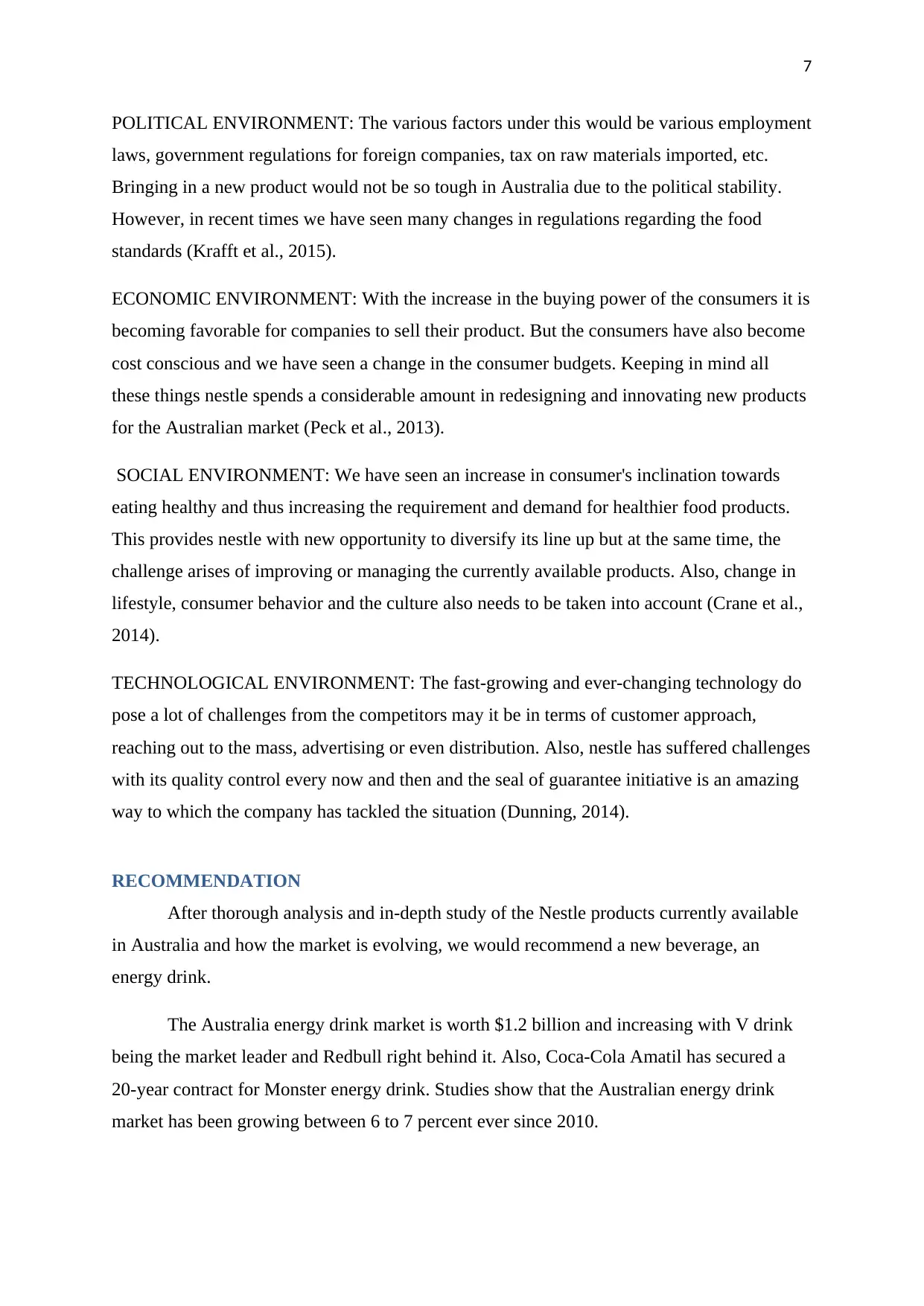
7
POLITICAL ENVIRONMENT: The various factors under this would be various employment
laws, government regulations for foreign companies, tax on raw materials imported, etc.
Bringing in a new product would not be so tough in Australia due to the political stability.
However, in recent times we have seen many changes in regulations regarding the food
standards (Krafft et al., 2015).
ECONOMIC ENVIRONMENT: With the increase in the buying power of the consumers it is
becoming favorable for companies to sell their product. But the consumers have also become
cost conscious and we have seen a change in the consumer budgets. Keeping in mind all
these things nestle spends a considerable amount in redesigning and innovating new products
for the Australian market (Peck et al., 2013).
SOCIAL ENVIRONMENT: We have seen an increase in consumer's inclination towards
eating healthy and thus increasing the requirement and demand for healthier food products.
This provides nestle with new opportunity to diversify its line up but at the same time, the
challenge arises of improving or managing the currently available products. Also, change in
lifestyle, consumer behavior and the culture also needs to be taken into account (Crane et al.,
2014).
TECHNOLOGICAL ENVIRONMENT: The fast-growing and ever-changing technology do
pose a lot of challenges from the competitors may it be in terms of customer approach,
reaching out to the mass, advertising or even distribution. Also, nestle has suffered challenges
with its quality control every now and then and the seal of guarantee initiative is an amazing
way to which the company has tackled the situation (Dunning, 2014).
RECOMMENDATION
After thorough analysis and in-depth study of the Nestle products currently available
in Australia and how the market is evolving, we would recommend a new beverage, an
energy drink.
The Australia energy drink market is worth $1.2 billion and increasing with V drink
being the market leader and Redbull right behind it. Also, Coca-Cola Amatil has secured a
20-year contract for Monster energy drink. Studies show that the Australian energy drink
market has been growing between 6 to 7 percent ever since 2010.
POLITICAL ENVIRONMENT: The various factors under this would be various employment
laws, government regulations for foreign companies, tax on raw materials imported, etc.
Bringing in a new product would not be so tough in Australia due to the political stability.
However, in recent times we have seen many changes in regulations regarding the food
standards (Krafft et al., 2015).
ECONOMIC ENVIRONMENT: With the increase in the buying power of the consumers it is
becoming favorable for companies to sell their product. But the consumers have also become
cost conscious and we have seen a change in the consumer budgets. Keeping in mind all
these things nestle spends a considerable amount in redesigning and innovating new products
for the Australian market (Peck et al., 2013).
SOCIAL ENVIRONMENT: We have seen an increase in consumer's inclination towards
eating healthy and thus increasing the requirement and demand for healthier food products.
This provides nestle with new opportunity to diversify its line up but at the same time, the
challenge arises of improving or managing the currently available products. Also, change in
lifestyle, consumer behavior and the culture also needs to be taken into account (Crane et al.,
2014).
TECHNOLOGICAL ENVIRONMENT: The fast-growing and ever-changing technology do
pose a lot of challenges from the competitors may it be in terms of customer approach,
reaching out to the mass, advertising or even distribution. Also, nestle has suffered challenges
with its quality control every now and then and the seal of guarantee initiative is an amazing
way to which the company has tackled the situation (Dunning, 2014).
RECOMMENDATION
After thorough analysis and in-depth study of the Nestle products currently available
in Australia and how the market is evolving, we would recommend a new beverage, an
energy drink.
The Australia energy drink market is worth $1.2 billion and increasing with V drink
being the market leader and Redbull right behind it. Also, Coca-Cola Amatil has secured a
20-year contract for Monster energy drink. Studies show that the Australian energy drink
market has been growing between 6 to 7 percent ever since 2010.
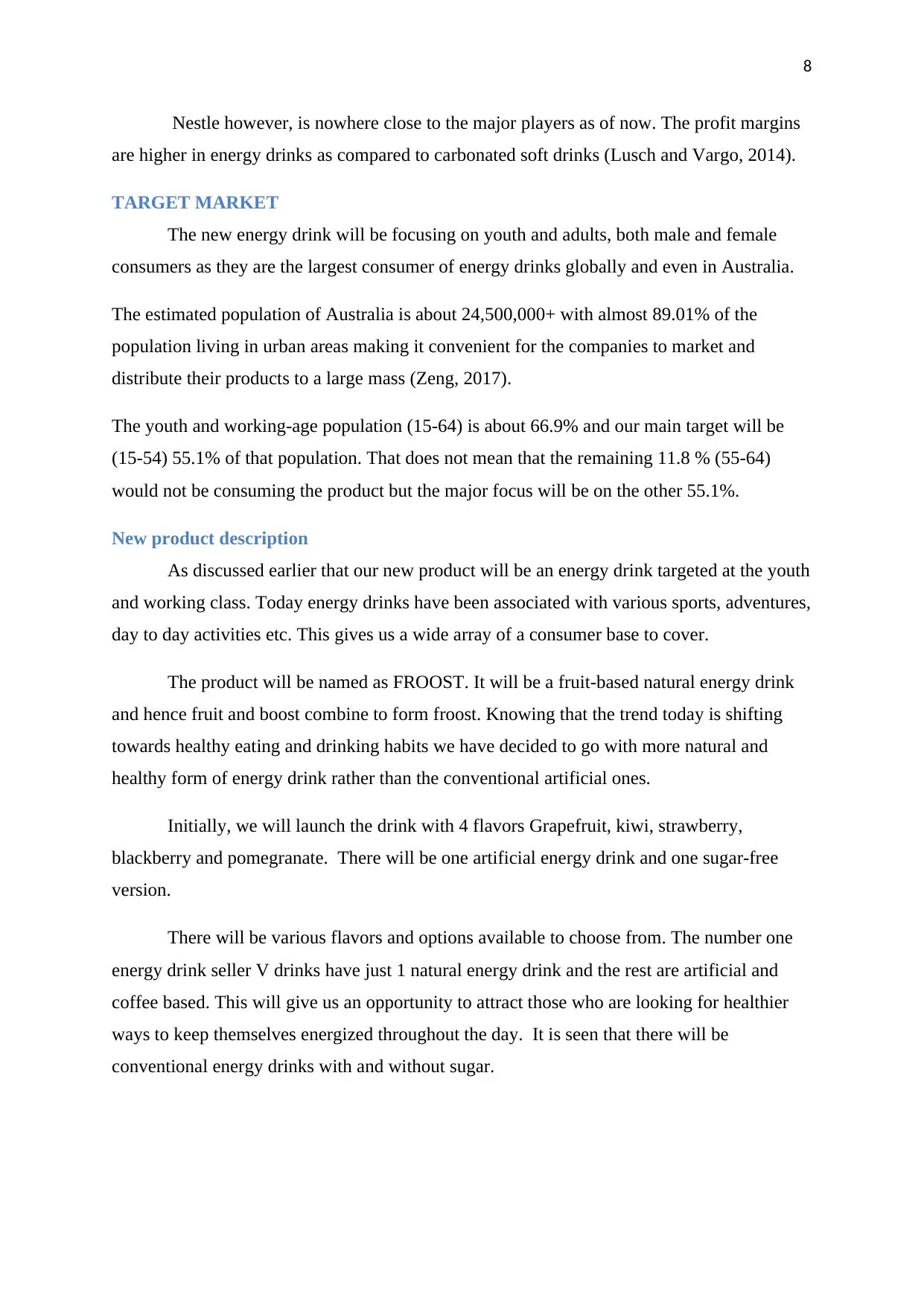
8
Nestle however, is nowhere close to the major players as of now. The profit margins
are higher in energy drinks as compared to carbonated soft drinks (Lusch and Vargo, 2014).
TARGET MARKET
The new energy drink will be focusing on youth and adults, both male and female
consumers as they are the largest consumer of energy drinks globally and even in Australia.
The estimated population of Australia is about 24,500,000+ with almost 89.01% of the
population living in urban areas making it convenient for the companies to market and
distribute their products to a large mass (Zeng, 2017).
The youth and working-age population (15-64) is about 66.9% and our main target will be
(15-54) 55.1% of that population. That does not mean that the remaining 11.8 % (55-64)
would not be consuming the product but the major focus will be on the other 55.1%.
New product description
As discussed earlier that our new product will be an energy drink targeted at the youth
and working class. Today energy drinks have been associated with various sports, adventures,
day to day activities etc. This gives us a wide array of a consumer base to cover.
The product will be named as FROOST. It will be a fruit-based natural energy drink
and hence fruit and boost combine to form froost. Knowing that the trend today is shifting
towards healthy eating and drinking habits we have decided to go with more natural and
healthy form of energy drink rather than the conventional artificial ones.
Initially, we will launch the drink with 4 flavors Grapefruit, kiwi, strawberry,
blackberry and pomegranate. There will be one artificial energy drink and one sugar-free
version.
There will be various flavors and options available to choose from. The number one
energy drink seller V drinks have just 1 natural energy drink and the rest are artificial and
coffee based. This will give us an opportunity to attract those who are looking for healthier
ways to keep themselves energized throughout the day. It is seen that there will be
conventional energy drinks with and without sugar.
Nestle however, is nowhere close to the major players as of now. The profit margins
are higher in energy drinks as compared to carbonated soft drinks (Lusch and Vargo, 2014).
TARGET MARKET
The new energy drink will be focusing on youth and adults, both male and female
consumers as they are the largest consumer of energy drinks globally and even in Australia.
The estimated population of Australia is about 24,500,000+ with almost 89.01% of the
population living in urban areas making it convenient for the companies to market and
distribute their products to a large mass (Zeng, 2017).
The youth and working-age population (15-64) is about 66.9% and our main target will be
(15-54) 55.1% of that population. That does not mean that the remaining 11.8 % (55-64)
would not be consuming the product but the major focus will be on the other 55.1%.
New product description
As discussed earlier that our new product will be an energy drink targeted at the youth
and working class. Today energy drinks have been associated with various sports, adventures,
day to day activities etc. This gives us a wide array of a consumer base to cover.
The product will be named as FROOST. It will be a fruit-based natural energy drink
and hence fruit and boost combine to form froost. Knowing that the trend today is shifting
towards healthy eating and drinking habits we have decided to go with more natural and
healthy form of energy drink rather than the conventional artificial ones.
Initially, we will launch the drink with 4 flavors Grapefruit, kiwi, strawberry,
blackberry and pomegranate. There will be one artificial energy drink and one sugar-free
version.
There will be various flavors and options available to choose from. The number one
energy drink seller V drinks have just 1 natural energy drink and the rest are artificial and
coffee based. This will give us an opportunity to attract those who are looking for healthier
ways to keep themselves energized throughout the day. It is seen that there will be
conventional energy drinks with and without sugar.
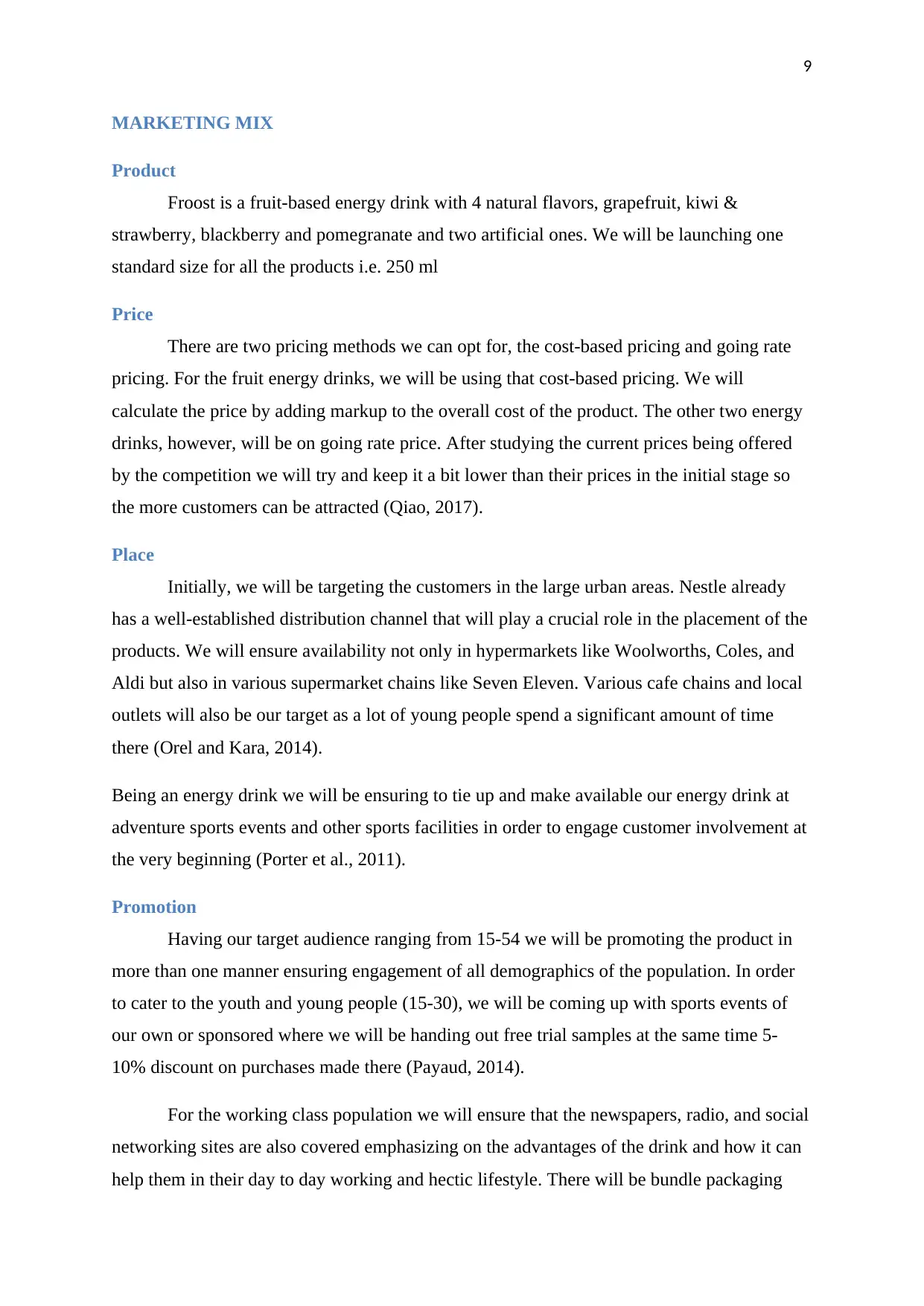
9
MARKETING MIX
Product
Froost is a fruit-based energy drink with 4 natural flavors, grapefruit, kiwi &
strawberry, blackberry and pomegranate and two artificial ones. We will be launching one
standard size for all the products i.e. 250 ml
Price
There are two pricing methods we can opt for, the cost-based pricing and going rate
pricing. For the fruit energy drinks, we will be using that cost-based pricing. We will
calculate the price by adding markup to the overall cost of the product. The other two energy
drinks, however, will be on going rate price. After studying the current prices being offered
by the competition we will try and keep it a bit lower than their prices in the initial stage so
the more customers can be attracted (Qiao, 2017).
Place
Initially, we will be targeting the customers in the large urban areas. Nestle already
has a well-established distribution channel that will play a crucial role in the placement of the
products. We will ensure availability not only in hypermarkets like Woolworths, Coles, and
Aldi but also in various supermarket chains like Seven Eleven. Various cafe chains and local
outlets will also be our target as a lot of young people spend a significant amount of time
there (Orel and Kara, 2014).
Being an energy drink we will be ensuring to tie up and make available our energy drink at
adventure sports events and other sports facilities in order to engage customer involvement at
the very beginning (Porter et al., 2011).
Promotion
Having our target audience ranging from 15-54 we will be promoting the product in
more than one manner ensuring engagement of all demographics of the population. In order
to cater to the youth and young people (15-30), we will be coming up with sports events of
our own or sponsored where we will be handing out free trial samples at the same time 5-
10% discount on purchases made there (Payaud, 2014).
For the working class population we will ensure that the newspapers, radio, and social
networking sites are also covered emphasizing on the advantages of the drink and how it can
help them in their day to day working and hectic lifestyle. There will be bundle packaging
MARKETING MIX
Product
Froost is a fruit-based energy drink with 4 natural flavors, grapefruit, kiwi &
strawberry, blackberry and pomegranate and two artificial ones. We will be launching one
standard size for all the products i.e. 250 ml
Price
There are two pricing methods we can opt for, the cost-based pricing and going rate
pricing. For the fruit energy drinks, we will be using that cost-based pricing. We will
calculate the price by adding markup to the overall cost of the product. The other two energy
drinks, however, will be on going rate price. After studying the current prices being offered
by the competition we will try and keep it a bit lower than their prices in the initial stage so
the more customers can be attracted (Qiao, 2017).
Place
Initially, we will be targeting the customers in the large urban areas. Nestle already
has a well-established distribution channel that will play a crucial role in the placement of the
products. We will ensure availability not only in hypermarkets like Woolworths, Coles, and
Aldi but also in various supermarket chains like Seven Eleven. Various cafe chains and local
outlets will also be our target as a lot of young people spend a significant amount of time
there (Orel and Kara, 2014).
Being an energy drink we will be ensuring to tie up and make available our energy drink at
adventure sports events and other sports facilities in order to engage customer involvement at
the very beginning (Porter et al., 2011).
Promotion
Having our target audience ranging from 15-54 we will be promoting the product in
more than one manner ensuring engagement of all demographics of the population. In order
to cater to the youth and young people (15-30), we will be coming up with sports events of
our own or sponsored where we will be handing out free trial samples at the same time 5-
10% discount on purchases made there (Payaud, 2014).
For the working class population we will ensure that the newspapers, radio, and social
networking sites are also covered emphasizing on the advantages of the drink and how it can
help them in their day to day working and hectic lifestyle. There will be bundle packaging
Secure Best Marks with AI Grader
Need help grading? Try our AI Grader for instant feedback on your assignments.
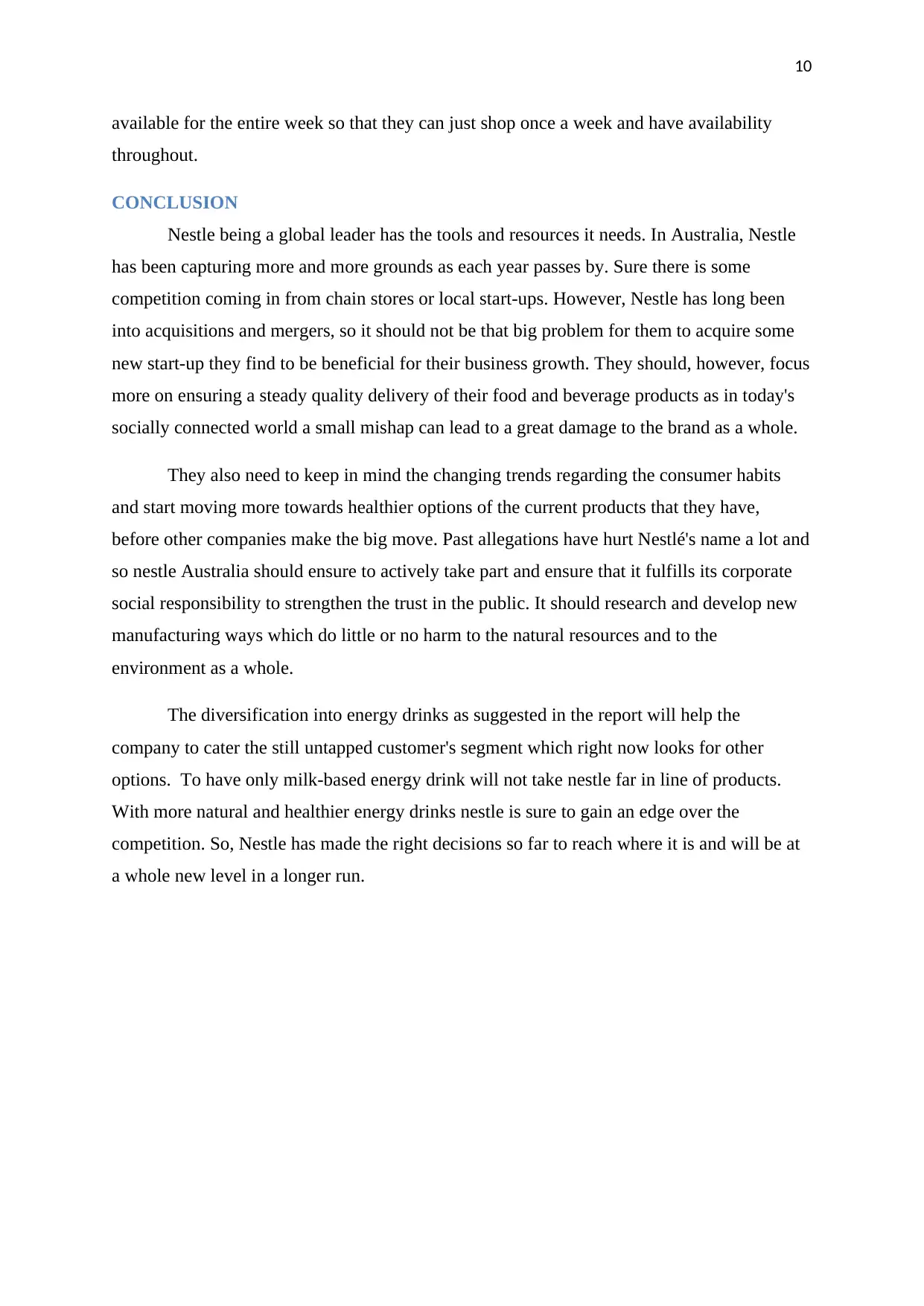
10
available for the entire week so that they can just shop once a week and have availability
throughout.
CONCLUSION
Nestle being a global leader has the tools and resources it needs. In Australia, Nestle
has been capturing more and more grounds as each year passes by. Sure there is some
competition coming in from chain stores or local start-ups. However, Nestle has long been
into acquisitions and mergers, so it should not be that big problem for them to acquire some
new start-up they find to be beneficial for their business growth. They should, however, focus
more on ensuring a steady quality delivery of their food and beverage products as in today's
socially connected world a small mishap can lead to a great damage to the brand as a whole.
They also need to keep in mind the changing trends regarding the consumer habits
and start moving more towards healthier options of the current products that they have,
before other companies make the big move. Past allegations have hurt Nestlé's name a lot and
so nestle Australia should ensure to actively take part and ensure that it fulfills its corporate
social responsibility to strengthen the trust in the public. It should research and develop new
manufacturing ways which do little or no harm to the natural resources and to the
environment as a whole.
The diversification into energy drinks as suggested in the report will help the
company to cater the still untapped customer's segment which right now looks for other
options. To have only milk-based energy drink will not take nestle far in line of products.
With more natural and healthier energy drinks nestle is sure to gain an edge over the
competition. So, Nestle has made the right decisions so far to reach where it is and will be at
a whole new level in a longer run.
available for the entire week so that they can just shop once a week and have availability
throughout.
CONCLUSION
Nestle being a global leader has the tools and resources it needs. In Australia, Nestle
has been capturing more and more grounds as each year passes by. Sure there is some
competition coming in from chain stores or local start-ups. However, Nestle has long been
into acquisitions and mergers, so it should not be that big problem for them to acquire some
new start-up they find to be beneficial for their business growth. They should, however, focus
more on ensuring a steady quality delivery of their food and beverage products as in today's
socially connected world a small mishap can lead to a great damage to the brand as a whole.
They also need to keep in mind the changing trends regarding the consumer habits
and start moving more towards healthier options of the current products that they have,
before other companies make the big move. Past allegations have hurt Nestlé's name a lot and
so nestle Australia should ensure to actively take part and ensure that it fulfills its corporate
social responsibility to strengthen the trust in the public. It should research and develop new
manufacturing ways which do little or no harm to the natural resources and to the
environment as a whole.
The diversification into energy drinks as suggested in the report will help the
company to cater the still untapped customer's segment which right now looks for other
options. To have only milk-based energy drink will not take nestle far in line of products.
With more natural and healthier energy drinks nestle is sure to gain an edge over the
competition. So, Nestle has made the right decisions so far to reach where it is and will be at
a whole new level in a longer run.
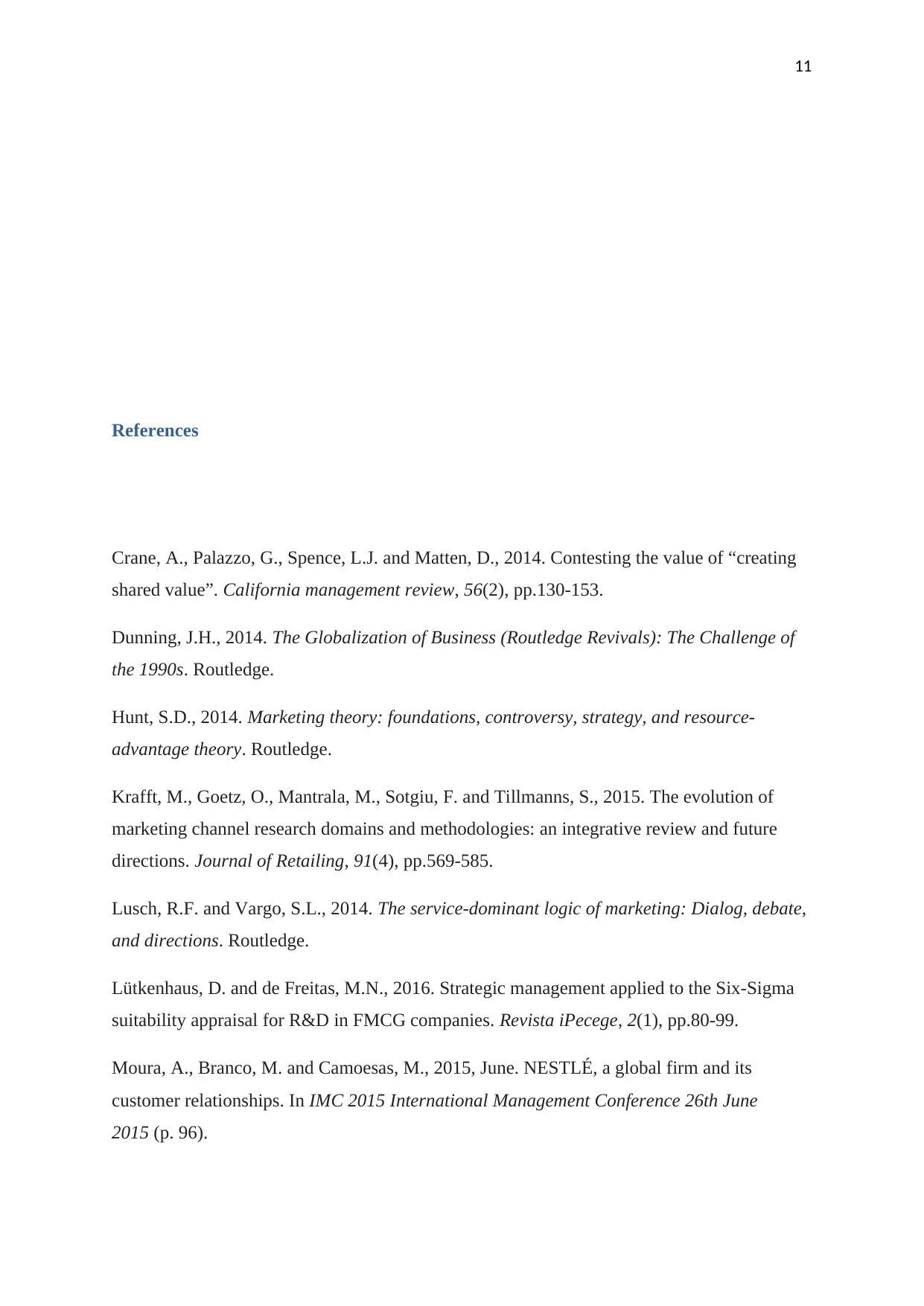
11
References
Crane, A., Palazzo, G., Spence, L.J. and Matten, D., 2014. Contesting the value of “creating
shared value”. California management review, 56(2), pp.130-153.
Dunning, J.H., 2014. The Globalization of Business (Routledge Revivals): The Challenge of
the 1990s. Routledge.
Hunt, S.D., 2014. Marketing theory: foundations, controversy, strategy, and resource-
advantage theory. Routledge.
Krafft, M., Goetz, O., Mantrala, M., Sotgiu, F. and Tillmanns, S., 2015. The evolution of
marketing channel research domains and methodologies: an integrative review and future
directions. Journal of Retailing, 91(4), pp.569-585.
Lusch, R.F. and Vargo, S.L., 2014. The service-dominant logic of marketing: Dialog, debate,
and directions. Routledge.
Lütkenhaus, D. and de Freitas, M.N., 2016. Strategic management applied to the Six-Sigma
suitability appraisal for R&D in FMCG companies. Revista iPecege, 2(1), pp.80-99.
Moura, A., Branco, M. and Camoesas, M., 2015, June. NESTLÉ, a global firm and its
customer relationships. In IMC 2015 International Management Conference 26th June
2015 (p. 96).
References
Crane, A., Palazzo, G., Spence, L.J. and Matten, D., 2014. Contesting the value of “creating
shared value”. California management review, 56(2), pp.130-153.
Dunning, J.H., 2014. The Globalization of Business (Routledge Revivals): The Challenge of
the 1990s. Routledge.
Hunt, S.D., 2014. Marketing theory: foundations, controversy, strategy, and resource-
advantage theory. Routledge.
Krafft, M., Goetz, O., Mantrala, M., Sotgiu, F. and Tillmanns, S., 2015. The evolution of
marketing channel research domains and methodologies: an integrative review and future
directions. Journal of Retailing, 91(4), pp.569-585.
Lusch, R.F. and Vargo, S.L., 2014. The service-dominant logic of marketing: Dialog, debate,
and directions. Routledge.
Lütkenhaus, D. and de Freitas, M.N., 2016. Strategic management applied to the Six-Sigma
suitability appraisal for R&D in FMCG companies. Revista iPecege, 2(1), pp.80-99.
Moura, A., Branco, M. and Camoesas, M., 2015, June. NESTLÉ, a global firm and its
customer relationships. In IMC 2015 International Management Conference 26th June
2015 (p. 96).
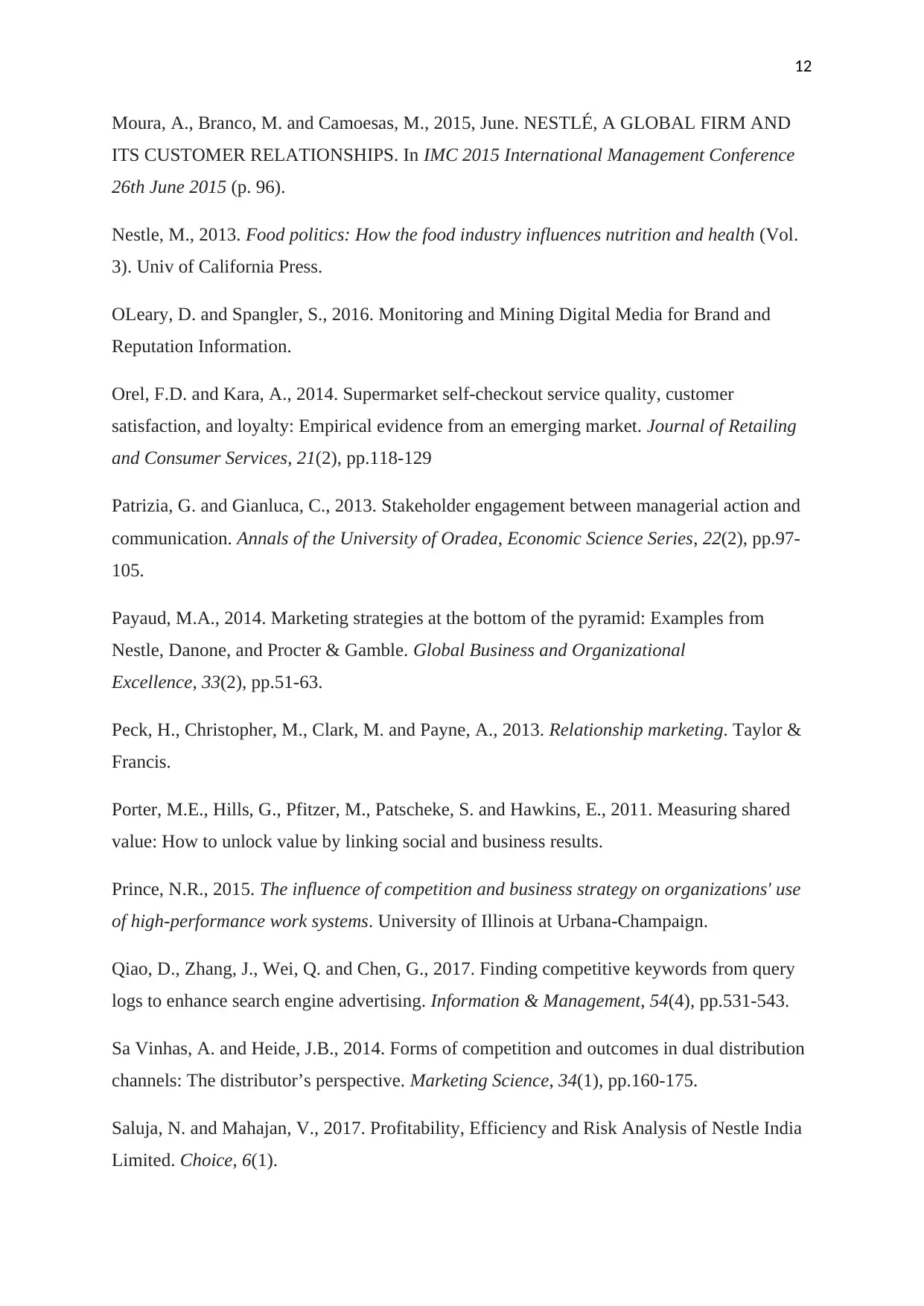
12
Moura, A., Branco, M. and Camoesas, M., 2015, June. NESTLÉ, A GLOBAL FIRM AND
ITS CUSTOMER RELATIONSHIPS. In IMC 2015 International Management Conference
26th June 2015 (p. 96).
Nestle, M., 2013. Food politics: How the food industry influences nutrition and health (Vol.
3). Univ of California Press.
OLeary, D. and Spangler, S., 2016. Monitoring and Mining Digital Media for Brand and
Reputation Information.
Orel, F.D. and Kara, A., 2014. Supermarket self-checkout service quality, customer
satisfaction, and loyalty: Empirical evidence from an emerging market. Journal of Retailing
and Consumer Services, 21(2), pp.118-129
Patrizia, G. and Gianluca, C., 2013. Stakeholder engagement between managerial action and
communication. Annals of the University of Oradea, Economic Science Series, 22(2), pp.97-
105.
Payaud, M.A., 2014. Marketing strategies at the bottom of the pyramid: Examples from
Nestle, Danone, and Procter & Gamble. Global Business and Organizational
Excellence, 33(2), pp.51-63.
Peck, H., Christopher, M., Clark, M. and Payne, A., 2013. Relationship marketing. Taylor &
Francis.
Porter, M.E., Hills, G., Pfitzer, M., Patscheke, S. and Hawkins, E., 2011. Measuring shared
value: How to unlock value by linking social and business results.
Prince, N.R., 2015. The influence of competition and business strategy on organizations' use
of high-performance work systems. University of Illinois at Urbana-Champaign.
Qiao, D., Zhang, J., Wei, Q. and Chen, G., 2017. Finding competitive keywords from query
logs to enhance search engine advertising. Information & Management, 54(4), pp.531-543.
Sa Vinhas, A. and Heide, J.B., 2014. Forms of competition and outcomes in dual distribution
channels: The distributor’s perspective. Marketing Science, 34(1), pp.160-175.
Saluja, N. and Mahajan, V., 2017. Profitability, Efficiency and Risk Analysis of Nestle India
Limited. Choice, 6(1).
Moura, A., Branco, M. and Camoesas, M., 2015, June. NESTLÉ, A GLOBAL FIRM AND
ITS CUSTOMER RELATIONSHIPS. In IMC 2015 International Management Conference
26th June 2015 (p. 96).
Nestle, M., 2013. Food politics: How the food industry influences nutrition and health (Vol.
3). Univ of California Press.
OLeary, D. and Spangler, S., 2016. Monitoring and Mining Digital Media for Brand and
Reputation Information.
Orel, F.D. and Kara, A., 2014. Supermarket self-checkout service quality, customer
satisfaction, and loyalty: Empirical evidence from an emerging market. Journal of Retailing
and Consumer Services, 21(2), pp.118-129
Patrizia, G. and Gianluca, C., 2013. Stakeholder engagement between managerial action and
communication. Annals of the University of Oradea, Economic Science Series, 22(2), pp.97-
105.
Payaud, M.A., 2014. Marketing strategies at the bottom of the pyramid: Examples from
Nestle, Danone, and Procter & Gamble. Global Business and Organizational
Excellence, 33(2), pp.51-63.
Peck, H., Christopher, M., Clark, M. and Payne, A., 2013. Relationship marketing. Taylor &
Francis.
Porter, M.E., Hills, G., Pfitzer, M., Patscheke, S. and Hawkins, E., 2011. Measuring shared
value: How to unlock value by linking social and business results.
Prince, N.R., 2015. The influence of competition and business strategy on organizations' use
of high-performance work systems. University of Illinois at Urbana-Champaign.
Qiao, D., Zhang, J., Wei, Q. and Chen, G., 2017. Finding competitive keywords from query
logs to enhance search engine advertising. Information & Management, 54(4), pp.531-543.
Sa Vinhas, A. and Heide, J.B., 2014. Forms of competition and outcomes in dual distribution
channels: The distributor’s perspective. Marketing Science, 34(1), pp.160-175.
Saluja, N. and Mahajan, V., 2017. Profitability, Efficiency and Risk Analysis of Nestle India
Limited. Choice, 6(1).
1 out of 13
Related Documents
Your All-in-One AI-Powered Toolkit for Academic Success.
+13062052269
info@desklib.com
Available 24*7 on WhatsApp / Email
![[object Object]](/_next/static/media/star-bottom.7253800d.svg)
Unlock your academic potential
© 2024 | Zucol Services PVT LTD | All rights reserved.





